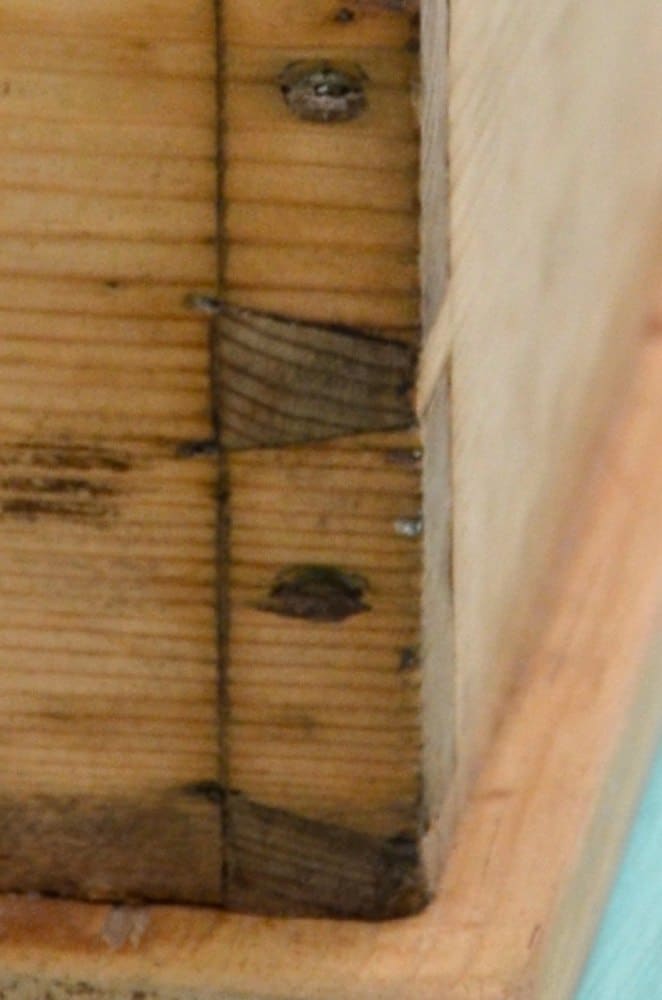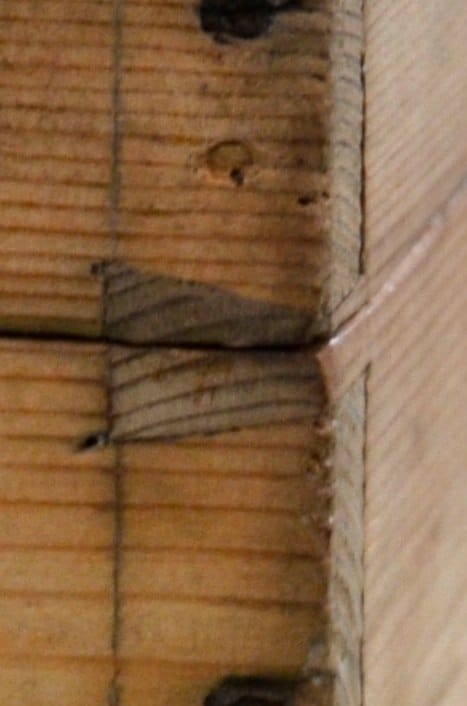Historical Perspectives Still Holding Good For Our Future
The future of woodworking seems ever brighter when I look in on times past.. I spend time still after all these years looking at the work of those who went before me. Tenons and dovetails aren’t at all new to me but they are filled with information about standards of workmanship, methods of work and working, material types, sizing and of course the obvious things such as style.
For much of my life I have seen dovetails nailed with a single pin through each dovetail. People today often describe this as slipshod. When I made my first dovetailed Joiner’s tool box I was told to nail the dovetails and that’s what I did. Just like the ones shown here but with oval nails. In most cases the nail mattered very little because boxes in pine were always painted for protective sealing and appearance. Boxes were of course the pre-plastic days and ways for transporting dry goods, storing them and of course keeping them safe. Today we see poor substitutes for wooden boxes that have no real joints but glue, staples and wood filler that might look good but have no built in longevity. What a difference to think a box might last over a hundred years and even two and three and still be going strong.
A close look at these boxes shows gauge lines that actually seemed to make very little difference to the maker.
Looking in closely the shoulder lines were often strayed from and so too as ever the depth of cuts of saws.
The alignment of angles too seemed of secondary importance and all of this shows my point. The boxes were made quickly and with tolerances close enough to guarantee strength yet without being overly concerned with accuracy.
Look at the marking gauge lines on this box corner above where I have enlarged the area around the meeting point where the lid is parted for the opening. This was the greatest discrepancy of about 1.5mm. Not a close tolerance at all but the joint is tightly made.

Saw kerfs rarely stopped at the lines on vernacular boxes like these. New woodworkers may not be aware of this. What’s your box for? Tools or a fine secretaire. Perhaps a beehive or a kitchen box holding onions and potatoes.
The angles to the dovetails are all different and though close not close enough for the maker to have used a dovetail guide. The spacings are different too. Layout was unlikely.
Fast, effective, practical woodworking at its best. Economy of time, materials and real woodworking.
I liked the last box quite well. Added decoration nailed in place and then signs throughout of paint removed. If the craftsman who made this was never known we know he passed on the traditions of dovetails purely by sighting his dovetails too. You are right again, they are not brilliantly executed but simply and effectively done to store things he really valued.







Well, I feel much, much better about my own dovetails now. 🙂
The nailed dovetails I find interesting. In outfitting my tool chest I made several dovetail joints without glue, I nailed them with toothpicks. On the dovetail joints where I didn’t nail both the tails and pins. I nailed through the pins, so that they couldn’t slide out, locking the joint (the tails are already locked by the pins). In that first box you showed, where the dovetails are nailed, they are nailed through the tails. I do realize that iron nails are harder to pull out then my toothpicks, but I do find the difference interesting.
It begs the question. Dovetail and nails only, or glue as well?
I have come across unglued dovetails only rarely. I forgot to mention that nails were seen more as temporary clamps with exact positioning to each dovetail until the glue dried and were indeed left in place. That way you could keep on working on the project. So too screws and glue for that matter. People seem to think using a nail or screw is something really negative. I don’t feel the same way at all. The problem is when they replace the joint for me.
I find that people today expect machine like precision in my finish work yet it is obvious that carpenter’s of old didn’t necessarily live up to that standard. They did some great work but in some cases they just did it good enough and moved on.
I have written on this in the past but a man was telling me once how is work was much finer than the work in the Penrhyn castle where we have our workshop. I was bemused and doubtful. I asked him why and he said that his dovetails were perfect. I asked him how long he took to make a drawer with dovetails. He said something like a day. I told him that typically a furniture maker was allowed six full drawers per day and that included grooves, joints front and back and fitted to the chest. Big difference. I too like nicely made dovetails. Here is a post I did a few years back.
A very helpful post Paul. The trend today is to put joinery on display for all to see. I’m as guilty as anyone on this point. We hobby woodworkers tend to be a little vain in our new found skills. Especially when it comes to dovetails. I’ve read a few old woodworking books that made a distinction between “paint grade” and “fine grade” dovetails. More over, craftsman used to go to great pains to hide joinery in finer furniture works. Full blind, mitered dovetails only need to be strong. They can have all sorts of gaps and no one will be the wiser.
We strive for pristine joinery in all that we build today. This is a good goal and practice but we also need to remember fitness for use. Thanks for showing us some examples of real world woodworking.
Greg
I have seen some old house hold items items at flea markets that had quite loosely cut dovetails and then the gaps had been filled with thin wedges to create a tight fit. Was this a common method in the old days?
No. This is very different than people patching poor cuts to make themselves look good or feel better about themselves. Most craftsmen did not leave gaps and most craftsmen did nit stop at gauge lines. When I was trained we were trained not to use gauge lines. Someehow today that badge of merit is seeing gauge lines. I have even seen factory made products with routed dovetails overscored with gauge lines to make it look as though the dovetails were hand cut.
The items I saw were wooden items related to a farming household so one could assume that they were made by someone in that household and not by a professional woodworker so I guess it might have been the best way for them to tighten up their dovetails. Even if it wasn’t pretty, I thought it was a practical way to save a project that needed to be put to use as fast as possible.
I like practical and real more than pretty or indeed prissy. I don’t mind the wedges either really. Somehow it just seems more real even to see a gap. I look back on my early work when someone asked me if I wanted them to do something on a project I was making a hash of. I said no. I didn’t want something that represented falsehood. That’s how I feel about jigs and routers for the main part.
Hi Paul,
This is my first post but I have been following your blog for a number of weeks now. Anyway a while back I took the plunge and ordered your Artisan course (Full Set: Book & 7 DVDs) and I just felt the need to say thank you – and what a great set they are,
What I like about the way you teach and pass on information is that you tell it as it is, without doing it in a gibberish or boring way.
I have learnt SSSooo much from your DVDs, Book and Blog.
Keep up the good work, and thank’s again,
C Williams
Hi Paul,
I’ve seen reproduction of english toolboxes that were enterely held with big nails chincked (if that is the right world), also the four lateral panel that formed the body of the box where nailed from the end grain, without dovetail or other joints. In your experience, this is only a fast method of temporary construction, or it was strong enough for repeated shifts?
Also, I have some Indonesian furnitures, and for small drawers, like night tables, the front panel is held with the drawer’s sides with a rabbet joint, nailed (I think thare is a bit of glue, and the wood is teak). Do you think is again a fast method of construction (for reatively small pieces), or is a real good substitute for dovetails? It seems to held very well and there are no gaps between the front and the sides of the drawers.
Thanks very much,
Valerio.
It’s interesting to note the intergrown knot on the left side of the box which appears to have been taken from a single width board. More evidence to suggest the box was built more for practical use. Even though old, rustic and well used, it’s still a joy to admire the hand tool craftsmanship the builder acquired and lives on in their work.